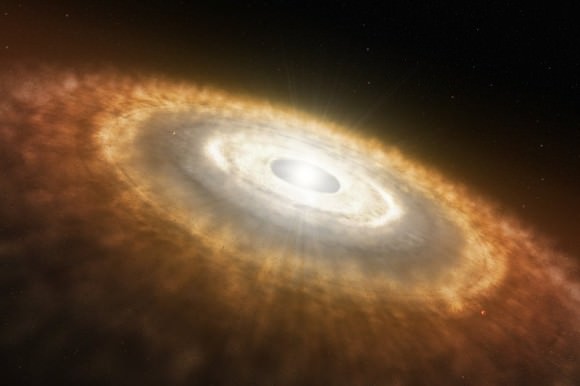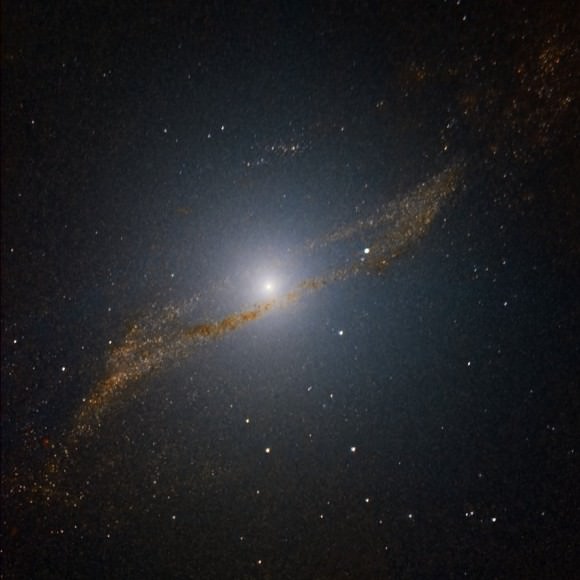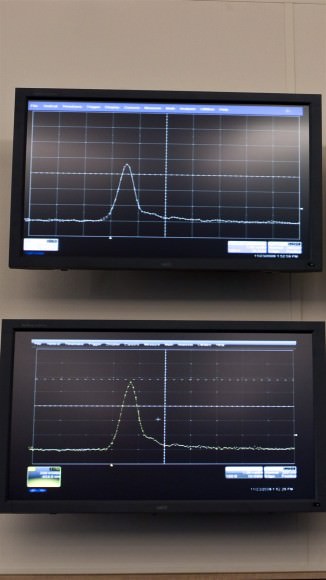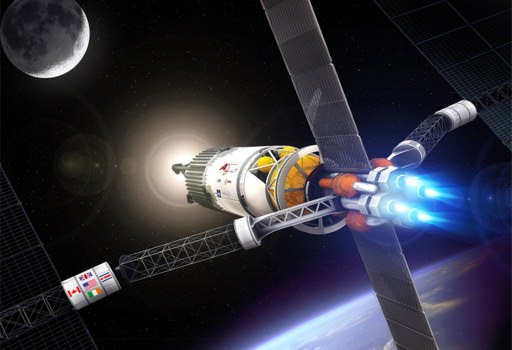First Black Holes May Have Formed in "Cocoons"
Very likely, the last image that comes to mind when thinking of black holes is that they need to be nurtured, coddled and protected when young. But new research reveals the first large black holes in the universe likely formed and grew deep inside gigantic, starlike cocoons that smothered their powerful x-ray radiation and prevented surrounding gases from being blown away.
(...)
Read the rest of First Black Holes May Have Formed in "Cocoons" (503 words)
NASA Science News for November 24, 2009
Data from NASA's STEREO spacecraft have confirmed the stunning reality of monster waves on the sun known as "solar tsunamis."
FULL STORY at
http://science.nasa.gov/headlines/y2009/24nov_solartsunami.htm?list1035898
The Extremely Large Telescope
The European Southern Observatory (ESO) is planning on building a massive – and I do mean massive – telescope in the next decade. The European Extremely Large Telescope (E-ELT) is a 42-meter telescope in its final planning stages. Weighing in at 5,000 tonnes, and made up of 984 individual mirrors, it will be able to image the discs of extrasolar planets and resolve individual stars in galaxies beyond the Local Group! By 2018 ESO hope to be using this gargantuan scope to stare so deep into space that they can actually see the Universe expanding!(...)
Read the rest of The Extremely Large Telescope (462 words)
Hot Jupiters Bully Super Earths

Bullies are everywhere and the universe is no exception. In our own solar system, Jupiter's mass is second only to that of the Sun. Its gravitational effects tug around a set of asteroids known as the Trojans and may prevent the asteroid belt from becoming anything more substantial. Fortunately, our humble planet gets along with this gravitational monstrosity, but it didn't have to be so. What could such massive menaces do to planets like Earth in newly forming solar systems?(...)
Read the rest of Hot Jupiters Bully Super Earths (579 words)
Cold as Hell with a Chance of Dust Storms: Weather Movies from M
If you think about it, those hypnotizing patterns of swirling clouds you see in TV weather reports are pretty amazing: satellites let us see what's happening in the skies all over the world. But these days, that kind of global vision even goes beyond the Earth. The Mars Reconnaissance Orbiter makes daily weather observations of the Red Planet, and mission scientists regularly compile the pictures into movies that are available online. The result is that anyone can follow along as fierce dust storms rage across the plains of Mars, clouds cling to the peaks of towering volcanoes and polar ice advances and retreats.(...)
Read the rest of Cold as Hell with a Chance of Dust Storms: Weather Movies from Mars (400 words)
First Collisions for the LHC
Two beams circulated simultaneously inside the Large Hadron Collider for the first time today, allowing for the first proton-proton collisions to take place. “It’s a great achievement to have come this far in so short a time,” said CERN Director General Rolf Heuer. “But we need to keep a sense of perspective – there’s still much to do before we can start the LHC physics program.”
(...)
Read the rest of First Collisions for the LHC (320 words)
Baby Brown Dwarfs Provide Clues to Solve Mystery

Why – and how — do brown dwarfs form? Since these cosmic misfits fall somewhere between planets and stars in terms of their temperature and mass, astronomers haven't yet been able to determine how they form: are their beginnings like planets or stars? Now, the Spitzer Space Telescope has found what could be two of the youngest brown dwarfs. While astronomers are still looking to confirm the finding of these so-called "proto brown dwarfs" it has provided a preliminary answer of how these unusual stars form.
(...)
Read the rest of Baby Brown Dwarfs Provide Clues to Solve Mystery (690 words)
Try Your Hand At Galaxy Zoo's New "Slot Machine"

Here's your chance to play online slot machines without risking your life savings. Plus it's an opportunity to contribute to a citizen science project that is sure to revolutionize our understanding of galaxy mergers. Galaxy Zoo's newest project asks for help in looking at colliding galaxies, and uses a tool akin to a cosmic slot machine to compare images of galactic pile-ups with millions of simulated mergers.
"The analogy I've been using is that it is like driving past a car crash," said Galaxy Zoo team member Chris Lintott from Oxford University. "You get a snapshot of the action, but there are two things you want to know: what caused the crash (or what did things look like before it all went wrong), and you want to know what the outcome is going to be. We're doing the same thing. We want to know what the galaxies looked like before the mergers started disrupting them, and we want to know how they are going to end up. Just like our other Galaxy Zoo projects, humans are much better at doing this than computers, and lots of humans are even better."
(...)
Read the rest of Try Your Hand At Galaxy Zoo's New "Slot Machine" (626 words)
Ring of Stars in Centaurus A Uncovered

Centaurus A (NGC 5128) is one of the most studied objects in the Southern sky, because it is the giant elliptical galaxy with the closest proximity to our own Milky Way. It lies 11 million light years away from the Milky Way, and is believe to have merged with another gaseous galaxy about 200 to 700 million years ago. The result of this galactic mashup: the birth of hundreds of thousands of stars in a kiloparsec-spanning ring near the core.(...)
Read the rest of Ring of Stars in Centaurus A Uncovered (907 words)
De Plume! De Plume! Enceladus Raw Flyby Images
Raw images are already being returned from Cassini's Nov. 21 "E-8" or eighth flyby of the tiger-striped moon Enceladus. Visible in this raw image are several plumes from fissures in the south polar region of the moon. These fissures spew jets of water vapor and other particles hundreds of kilometers from the surface. This flyby included a very different geometry to the flyby trajectory – and a different look at the plumes — approaching within 1,606 kilometers (997.9 miles) of the surface, buzzing over 82 degrees south latitude. This is the last look we'll have for several years at this intriguing area of Enceladus before winter darkness blankets the area. See below for looks at Baghdad Sulcus, the "tiger stripe" that scientists were focusing on.
(...)
Read the rest of De Plume! De Plume! Enceladus Raw Flyby Images (112 words)
Want to be a Martian?

If you've ever dreamed of exploring Mars, but are worried about all that pesky radiation exposure and being cramped in a capsule for the two-year flight – or about never coming back – then your dream may be realized with NASA's "Be a Martian" web site. In the spirit of other citizen scientist collaborations such as Galazy Zoo and Stardust@Home, NASA has created a site that allows you to view and categorize images to help map the Martian surface from the safety of your own home here on Earth.
(...)
Read the rest of Want to be a Martian? (380 words)
More Cassini Eye Candy: Infrared Saturn, Peek-a-boo Moons
The "wow" factor from the Cassini mission never quits. Here's the latest image, released just today of Saturn, viewed in near-infrared. This image was taken with Cassini's wide-angle camera on Oct. 23, 2009 using a spectral filter sensitive to wavelengths of near-infrared light, centered at 890 nanometers. The view was acquired at a distance of approximately 2.6 million kilometers (1.6 million miles) from Saturn. The large shadow south of the equator is from the moon Tethys (1062 kilometers, 660 miles across). The small shadow near the limb of the planet, north of the equator, is the shadow of the moon Mimas (396 kilometers, 246 miles across). Absolutely stunning.
See below for more Cassini goodness of moons playing peek-a-boo with the rings and each other.
(...)
Read the rest of More Cassini Eye Candy: Infrared Saturn, Peek-a-boo Moons (57 words)
Cassini/IBEX Data Changes View of Heliosphere Shape

Though the Cassini mission has focused intently on scientific exploration of Saturn and it's moons, data taken by the spacecraft has significantly changed the way astronomers think about the shape of our Solar System. As the Sun and planets travel through space, the bubble in which they reside has been thought to resemble a comet, with a long tail and blunt nose. Recent data from Cassini combined with that of other instruments, shows that the local intertstellar magnetic field shapes the heliosphere differently.(...)
Read the rest of Cassini/IBEX Data Changes View of Heliosphere Shape (553 words)
Black Hole Drive Could Power Future Starships

Image credit: NASA
What would happen if humans could deliberately create a black hole? Well, for starters we might just unlock the ultimate energy source to create the ultimate spacecraft engine — a potential "black hole-drive" – to propel ships to the stars.
It turns out black holes are not black at all; they give off "Hawking radiation" that causes them to lose energy (and therefore mass) over time. For large black holes, the amount of radiation produced is miniscule, but very small black holes rapidly turn their mass into a huge amount of energy.
(...)
Read the rest of Black Hole Drive Could Power Future Starships (402 words)
Plasma Rocket Could Help Pick Up Space Trash
Franklin Chang Diaz's proposed VASIMR rocket engine could create very versatile spacecraft. Not only does the plasma-fueled rocket have the potential to make a trip to Mars in just over a month, it could also help clean up space trash in Earth orbit. “Our goal is to be able to have a garbage truck that will be picking up all of these objects at various orbits,” astronaut Chang Diaz said in an article in the Global Post. The debris could put into an “orbital graveyard,” he added, “or we could actually launch them to the sun and drive them to the sun, which is kind of the ultimate, cosmic dump.”
(...)
Read the rest of Plasma Rocket Could Help Pick Up Space Trash (348 words)






